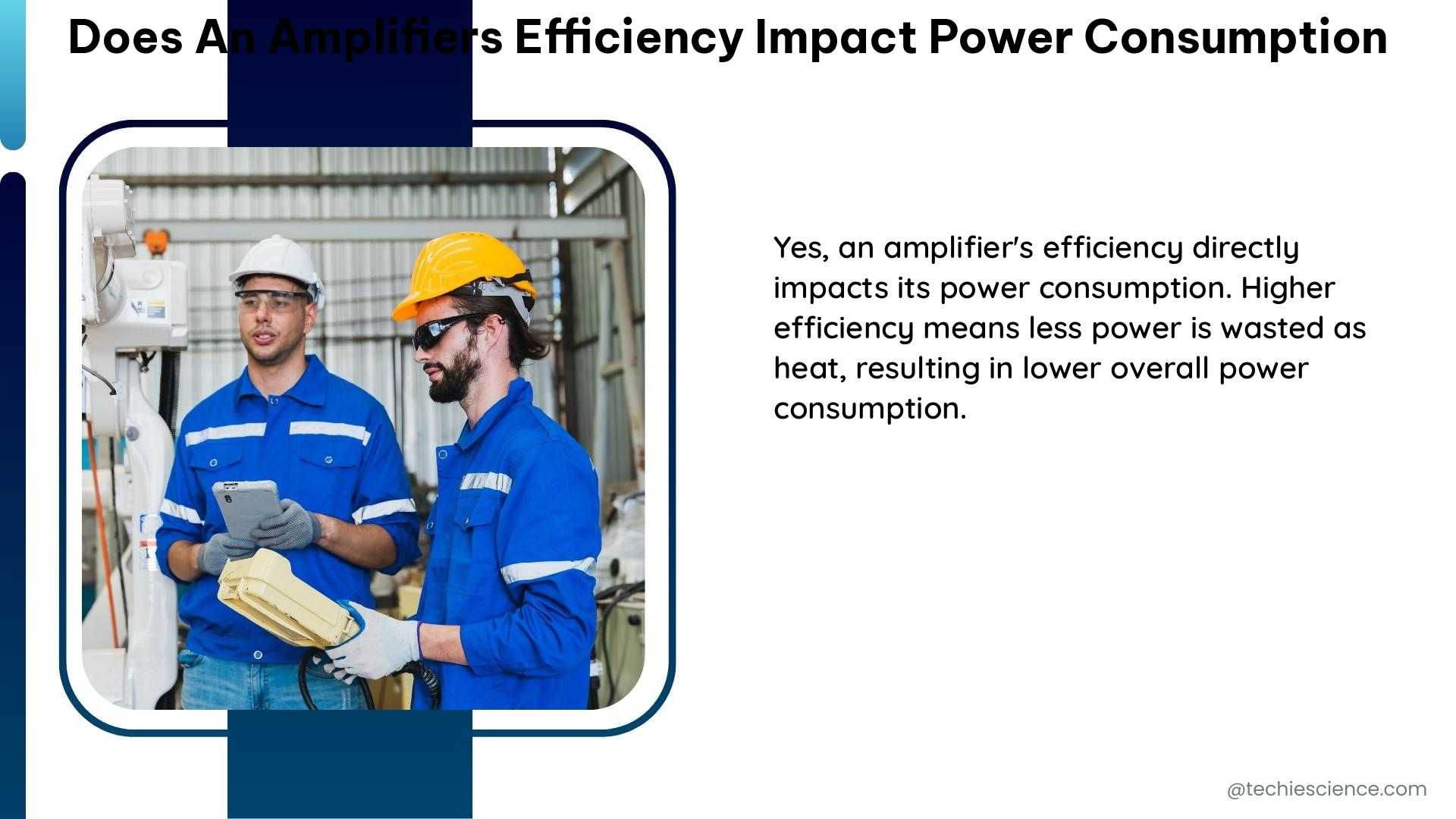An amplifier’s efficiency is a crucial factor that directly impacts its power consumption. The efficiency of an amplifier is defined as the ratio of the output power to the input power, and it is typically expressed as a percentage. This efficiency metric plays a significant role in determining the overall power consumption of the amplifier, as well as the system it is a part of.
Understanding Amplifier Efficiency
The efficiency of an amplifier is a measure of how effectively it converts the input power into useful output power. An amplifier with a higher efficiency will waste less power as heat, resulting in lower overall power consumption. Conversely, an amplifier with a lower efficiency will dissipate more power as heat, leading to higher power consumption.
The efficiency of an amplifier can be calculated using the following formula:
Efficiency (%) = (Output Power / Input Power) × 100
For example, an amplifier with an efficiency of 85% would waste 15% of the input power as heat. This means that for every 100 watts of input power, the amplifier would only produce 85 watts of useful output power, with the remaining 15 watts being dissipated as heat.
Power Added Efficiency (PAE)

One important metric for measuring the efficiency of a power amplifier is Power Added Efficiency (PAE). PAE takes into account the power added by the amplifier to the input signal, rather than just the output power.
PAE is defined as the ratio of the power added to the input signal to the DC power consumed by the amplifier, and is expressed as a percentage. The formula for calculating PAE is:
PAE (%) = [(Output Power - Input Power) / DC Power] × 100
A high PAE value indicates that the amplifier is adding a significant amount of power to the input signal while consuming relatively little DC power. This is particularly important in wireless communication systems, where the power amplifier (PA) is often the dominant single-block energy dissipater.
Importance of Amplifier Efficiency in Wireless Communication Systems
In the context of wireless communication systems, the efficiency of the RF power amplifier (PA) is critical because the PA is often the dominant single-block energy dissipater. Improving the efficiency of the PA can significantly reduce the overall power consumption of the system, which is crucial for battery-powered devices and energy-efficient network infrastructure.
A study published in 2024 presents a comprehensive system analysis of the total efficiency gains achievable in the RF parts of a multimode transmitter that uses supply-tracking regimes. The study found that by optimizing the supply-tracking regimes, the total efficiency of the RF parts of the transmitter can be significantly improved, resulting in a reduction in power consumption.
Another study published in 2023 proposes a new metric for analyzing power consumption in future wireless networks, called the power waste factor (W). The power waste factor is defined as the ratio of the total power consumed by the network to the power delivered to the users, and is expressed as a percentage. The study found that by optimizing the power waste factor, the energy efficiency of the network can be significantly improved.
Techniques for Improving Amplifier Efficiency
There are several techniques that can be used to improve the efficiency of power amplifiers, including:
-
Supply Tracking Regimes: This involves dynamically adjusting the supply voltage of the amplifier to match the input signal level, reducing the amount of power dissipated as heat.
-
Envelope Tracking: This technique uses a separate power supply that tracks the envelope of the input signal, allowing the main amplifier to operate at a higher efficiency.
-
Doherty Amplifier: This architecture uses a main amplifier and a peaking amplifier to improve efficiency, particularly at lower output power levels.
-
Gallium Nitride (GaN) Transistors: GaN transistors have higher breakdown voltages and lower on-resistance compared to traditional silicon-based transistors, allowing for more efficient power amplifier designs.
-
Linearization Techniques: Techniques such as digital predistortion and feedforward can be used to linearize the amplifier, reducing distortion and improving efficiency.
-
Load Modulation: This involves dynamically adjusting the load impedance of the amplifier to match the optimal load for a given output power level, improving efficiency.
-
Outphasing Amplifiers: This architecture combines two amplifiers operating in opposite phases to achieve high efficiency, particularly at lower output power levels.
By implementing these and other efficiency-enhancing techniques, the power consumption of amplifiers can be significantly reduced, leading to improved battery life, reduced cooling requirements, and more energy-efficient wireless communication systems.
Conclusion
In summary, an amplifier’s efficiency has a significant impact on its power consumption. By optimizing the efficiency of the amplifier, it is possible to significantly reduce the amount of power that is wasted as heat, resulting in a reduction in overall power consumption. Power Added Efficiency (PAE) is an important metric for measuring the efficiency of a power amplifier, and techniques such as supply tracking regimes, envelope tracking, and Doherty amplifiers can be used to improve the efficiency of power amplifiers, particularly in the context of wireless communication systems.
Reference:
- Power Added Efficiency (PAE) – ScienceDirect
- System-Efficiency Analysis of Power Amplifier Supply-Tracking Regimes in Mobile Transmitters
- Quantification of power amplifiers’ static and dynamic distortions using frequency domain metrics
- A New Metric for Analyzing Power Consumption in Future Wireless Networks
- Amplifier Efficiency – ScienceDirect

The lambdageeks.com Core SME Team is a group of experienced subject matter experts from diverse scientific and technical fields including Physics, Chemistry, Technology,Electronics & Electrical Engineering, Automotive, Mechanical Engineering. Our team collaborates to create high-quality, well-researched articles on a wide range of science and technology topics for the lambdageeks.com website.
All Our Senior SME are having more than 7 Years of experience in the respective fields . They are either Working Industry Professionals or assocaited With different Universities. Refer Our Authors Page to get to know About our Core SMEs.